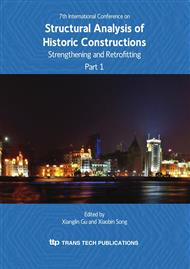p.97
p.107
p.113
p.119
p.125
p.131
p.137
p.143
p.149
From Simple Roof Structure Calculus Based on 2D Modelling to 3D Models–Case Study: Reformed Church in Cluj-N., Romania
Abstract:
Computer aided modelling, software options, as well as hardware performances have developed rapidly in the last several decades. Though the time required for building up a holistic 3D mechanical computer model for a baroque roof structure decreased significantly, it may be worth to stop at simple calculus, 2D or limited 3D modelling level, in various cases. Conclusions of the present lecture aim to identify the accuracy and reliability of the 4 levels of modelling. The recommendations formulated intend to identify the appropriate level of research according to the span, historic roof-type and state of decay of a given roof that is to be conserved. Research schemes are also suggested, aiming to offer an efficient tool for experts and engineers according to the complexity of the assessment.
Info:
Periodical:
Pages:
125-130
Citation:
Online since:
October 2010
Authors:
Price:
Сopyright:
© 2010 Trans Tech Publications Ltd. All Rights Reserved
Share:
Citation:


